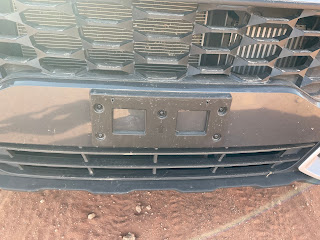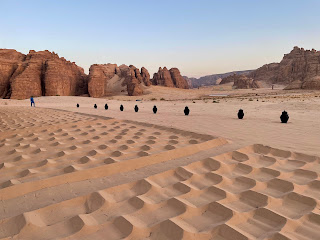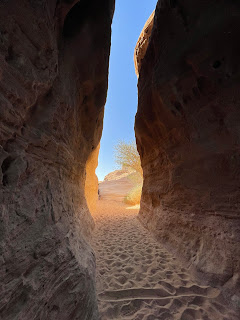"How did you like it?" Scott asked.
"We loved it!"
They used a tour company, added that it was hot, but not too hot, and that the desert was beautiful. Walking home that night, we talked about adding Saudi Arabia to our 2025 travel plans. "But let's do it on our own. Let's rent a car and camp in the desert," I said.
We did our research and found that camping in the desert might, or might not, be allowed. That sounded like OK odds to us. We bought a guidebook for Saudi Arabia from our favorite travel publisher, The Bradt Guide. It was published in 2023, so we hoped it would have the most up-to-date information. Bradt Guides tend to focus more on the culture and history of a place, than on places to sip, dip, and be hip. There would be no sipping in Saudi Arabia anyway, as alcohol is strictly prohibited. Could we survive 23 days without a G&T or a beer at sundown, that was the question.
We bought a one way ticket to Riyadh.
Our friend Yusuf lives mostly in Lamu, Kenya, but he was in Riyadh at the same time as our visit (see previous post, How Did I Catch the Travel Bug.) It was still Ramadan, so we met Yusuf and his daughter in the late afternoons before Iftar, the Muslim fast-breaking meal, at the cat-frequented, date-palm ringed sunken pool.
A local guide, Ahmed, drove Scott and me to The Edge of the World, which turns out to be only two and a half hours from Riyadh. The scenery on the way was spectacular, but wow, when we arrived at the 1000 foot high escarpment, I was pretty much blown away. I mean literally, not figuratively. After a short but steep climb, we found it to be extremely windy at the top. I could see why it’s called The Edge of the World because when I stood atop the sheer cliff to look out over the valley, the horizon looked endless. We climbed up to a few more overlooks and sat down on the cliff to take in the view.
Back down at the base, Ahmed set up three chairs for sunset viewing. He asked if we would like to eat something. "No thanks, we'll wait until Iftar, until you eat," I answered. Our sundowners that eve? Cardamom coffee and fresh dates. It was delicious. It was enough.
Leaving Riyadh, we flew to Jeddah and rented a car. I envisioned us getting a Land Rover, but all they had was a KIA Sportage.
Scott bought
my birthday presents at a camping store— tent, chairs, stove, fuel,
mats, pot, air compressor, blankets and sheets. My other birthday present was three
nights at The Jeddah Ritz. When he returned from the camping store, he was so
excited about showing me the tent (it was one of those nifty ones that looks
like a hula hoop when stowed in a bag but when you remove it, FOOF! it
becomes a tent), that he foofed it right on the king-sized bed in our
hotel room. It took him 45 minutes to get the toothpaste back in the
tube.
Our last night at the Ritz was my birthday. It was also the official end of Ramadan and the beginning of Eid, the multi-day festival that marks the end of Ramadan. Boy, were folks in good moods. Families gathered at the sea-side park across from the Ritz and enjoyed a feast together. Then, they took naps and watched football. Not really. But the vibe was very reminiscent of our Thanksgiving. It was very special for us to enjoy Iftar at the Ritz on the eve
of Eid. And Mrs. Scott was overly-spoiled by the staff all day long on her birthday.
After a visit to the Hyper Panda, a big box grocery store, we were set. We had our vehicle, complete with 4-wheel drive capability for all the camping we would do in the desert, and all the camping equipment we would need for all the camping we would do in the desert.
We drove north along the Red Sea from Jeddah, a city with one of the best preserved historic old towns in the world, and we stopped at hotels near the water each night; Yanbu, Umluj, Al Wajh were three of the cities we stayed. We gassed up whenever we came to a station, as distance between towns were big, and the KIA gas tank was small. Each evening we walked to the shore to watch sunset in my brand new camp chairs.
We'd read that it is not permitted to bush camp near the sea so our night under the stars would have to wait until the desert. Our chance would come the night we turned inland.
 |
| Many times during the trip, I yearned for Ndoto and her ultra comfy bed in our rooftop tent. |
Time to pivot. We booked a hotel in Tabuk. We were looking forward to visiting the Hijaz Railroad Museum in the morning.
The Hijaz Railway was built by the Ottomans in 1900 as a means to connect Hajj Pilgrims from Damascus to Mecca. We would be following the now defunct railway all the way from Tabuk to Medina, and we hoped to find the train that was derailed by T.E. Lawrence during WWI along the way.
"Oh shoot. Scott, The Railway Museum web site says it opens at 12:30 tomorrow, and Google says it opens at 1pm.” The museum was one of our 'must sees' in Saudi Arabia, so we agreed to delay our drive to Al Ula until 2:30 the next day and visit the museum when it opened. The Bradt Guide warned about trusting posted opening hours, but we were hopeful. The next morning, we drove to the museum at 12:30. Good sign; the door was unlocked. But a man quickly approached and said, "Closed today."
"Couldn't we have a short visit, please?" I pleaded. "Your web site says you are open."
"No. Closed today." Scott held his brains in again.
The good news is, during our 5-hour drive through the desert from Tabuk to Al Ula, we found the train that was ambushed and blown up by T.E. Lawrence (Lawrence of Arabia) over 100 years ago. We almost gave up because it was nowhere near the Google Maps dot. All along the desolate drive from Tabuk, we followed the former route of the Hijaz Railway. The tracks are long gone, but a raised embankment and some bridges appeared and disappeared throughout the day. But at the spot where Google Maps had us leaving the road, the ghost of the train track completely disappeared. We drove on. After ten miles I said, "Let's try over that hill," though it didn't look at all like train track territory. Five minutes later we spied the train sitting on its side, truly in the middle of nowhere. Victory! But there was a chain link fence surrounding it. The few train and history enthusiasts who visited the site in the past used to be able to walk right up to the overturned train. Now, access was denied. “I protest!”There were no signs of recent visitors; no tire tracks, no footprints. No signs of life except for camel prints.
 |
| Stock photo |
We wanted to get a photo from the other side, where we could see the train's smoke stack so, don't tell on us, but... Scott tried to lift the chain link gate off its guide. But it was stuck.
He just stood there. "Tris, your face is bright red already. You're going to die doing that in this heat." He refused to assist, so I settled for snapping photos from under the fence. Then he took a video of me trying to stand up. By George, it jolly well was hot out there! Woof!
The tourist industry, the way one might think of it in Europe or Asia, hasn't arrived yet in most of The Kingdom. Tourism in Saudi Arabia is mostly centered on Pilgrimages to Mecca and Medina, not that we would be able to travel to those sites anyway. Haram (forbidden) areas which surround Mecca (88 acres) and Medina, have police stationed at border posts, to insure that non-believers do not enter. Even the busy freeways have ring roads and directional signs; NON-MUSLIMS NOT ALLOWED TO ENTER in Arabic and English so that one won't make a wrong turn.
But if NEOM (neo--new and Mustaqbal the Arabic word for future (or, some say, the first initial of Mohammad bin Salman, the Prince who launched the project), and the vision for Saudi Arabia 2030 (establishment of Saudi Arabia as a Global Leader) come to fruition, Tourism is coming to Saudi Arabia, Big Time. If completed, NEOM will be a 10,000 square mile planned city on the Red Sea, complete with tourist resorts, flying cars, and robot maids. To-date it is enormously over budget and behind schedule. Not enough construction workers is part of the problem, though as we drove along the Red Sea north towards Jordon, there were what seemed to be vast, multi-story, newly-built foreign worker compounds. We met foreign workers from India, Nepal, Bangladesh, Pakistan, Uganda, Nigeria, Kashmir, Indonesia.... Everywhere we went in Saudi Arabia we encountered foreign workers, predominantly men, doing every job imaginable; hospitality, such as waiter or housekeeper, also agriculture, security, manager, shop keeper, even ice cream scooper at Baskin Robbins.
The foreign workers seem to do everything, except maybe front desk Reception and drive for UBER. Ever see the film, A Day without a Mexican? I think Saudi Arabia would completely collapse without its foreign workers.
NEOM, if it happens, will be for rich resort/golf types, so not the kind of tourism, for the most part, that brings income to local communities or mom and pops.
What you don't see today are useful things for travelers such as Tourist Information Centers, maps, reliable opening hours of museums and other sites independent travelers would want to see. We asked everywhere we went for a paper map of Saudi Arabia and Saudi cities. There weren't any.
We spent 23 days in Saudi Arabia. The heat forced us out. We camped in the desert one night, but it was the most beautiful night. We gave all our camping gear to the receptionist at the last hotel we stayed in Medina. She was thrilled. We drank Cardamom coffee, the best coffee in the world on the Edge of the World, and we ate more dates in 4 weeks than in our entire lives.
I had many opportunities to speak with Saudi women dressed in abaya and left with many sisterly hugs. I met a French-Spanish-Arabic-speaking Algerian man, Mohammed, who was in Jeddah for business and pilgrimage. We conversed in French and Spanish (sometimes in the same sentence.) The concierge at the Ritz, whose English was excellent, filled in the gaps for Mohammed in Arabic. Mohammed asked me if I was Muslim. “Non,” I answered in French. “But I respect devout people and am interested in the history of religions.” He responded “Moi aussi,” Me too. Then he shook my hand and told me I had a pure heart. 🥴 I left him with something a young man in the passenger seat of a delivery truck in Uganda passed on to Scott and me while we were stuck in a Kampala traffic jam with our windows down, “It is friends that build the world.”
Despite the challenges, I am thoroughly enchanted by Saudi Arabia, especially the desert. I liked— no loved— being there before rampant tourism. The hospitality was exceptional. It is a place like no other.
Scott’s head hurt.
 |
| We saw Abdullah again. He was so pleased we found a camp in the wild. So were we! |





































































































What a great "the road less travelled" adventure! I'm not sure Saudi Arabia would ever become Disney Land, but it's wonderful to see a place like that before it's been trampled. Having grown up in the Middle East, it's one place I've always been curious about. Thanks for taking me there. (Liz sympathizes about the heat).
ReplyDeleteThanks, John!
DeleteWanderlust and desert dust
ReplyDeleteI'm so glad you guys were curious about Saudi Arabia and just went! I never would have guessed that there were such interesting and awe-inspiring sights. Rhiannon and I loved your comments and photos, and we can't wait for the next chapter. Miss you!!
ReplyDelete